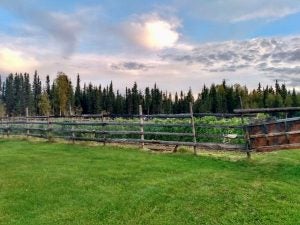On a trip to Alaska, I was surprised to hear how many people said, “You need to go see the giant cabbages!”
They were right. In an effort to learn more about this, I connected with farmer and owner of Salmon Run Farm, Brian Shunskis. Brian consistently takes first or second place at the Alaska State Fair for biggest cabbage, and this is a photo of a 65-pound head he brought to a farm stand where he sells local produce from his 2-acre organic farm in Salcha, Alaska.
“I have a bigger one on the farm! It’s nearly seven feet across!” He exclaimed. Of course, I had to see this Volkswagen of a cabbage with my own two eyes:
Sort of reminds you of the “Feed Me, Seymour” scene from “Little Shop of Horrors,” doesn’t it?
Farmer Brian believes this cabbage weighs over 100 pounds at the moment and grows about two to four pounds per day. When they are measured and weighed, they look at the entire plant. The current world record holder is Scott Robb who hails from Palmer, Alaska, with a head of cabbage weighing in at a whopping 138.25 pounds (62.71 kilos) at the 2012 Alaska State Fair. Brian is on a mission to beat it! So are some competitors in England, who are also known for their massive cabbage crop.
So why are they known for such big cabbages? A lot of it has to do with the long days, which can consist of over 23 hours of sunlight during the summer. Colder soil helps as well, which can make fruits and veggies more delicious with a higher sugar content! Since Alaska is so far north, it also filters out some of the harmful sun rays, giving cabbage ideal growing conditions. In the lower 48 states, the average larger-sized cabbage can grow to be about 15 pounds.
Of course, good seed matters too. Cabbage enthusiast Brian has been saving and cross breeding his own seeds for years. After the crop is harvested and the plant lies dormant for five months, seed shoots sprout, which he crosses to try to create the best seed. His organic farm uses only natural fertilizer from salmon, which definitely seems to do the trick! After he harvests, he’ll eat it and share with others. That’s a lot of coleslaw! He also grows a ton of other fruits and vegetables, including broccoli, corn, onions, strawberries, peas, beets, and fava beans, which I was not at all familiar with. Delicious!
What about predators? Hard for us in the lower 48 states to think of sometimes, but Alaskans’ biggest challenge is moose! The beasts will trample farms and love to eat the crop, so Brian has built this homemade fence to keep them out. Low budget, but with a unique look — and it works!

If you ever find yourself in Alaska, make sure to take some time to see the local agriculture. Alaskan farmers are very prideful, as it can be so expensive to import products and locals tend to look for that “Alaskan Grown” label. The state’s only major agricultural export is flowers.
Michelle Miller, the Farm Babe, is an Iowa-based farmer, public speaker, and writer, who lives and works with her boyfriend on their farm, which consists of row crops, beef cattle, and sheep. She believes education is key in bridging the gap between farmers and consumers.



